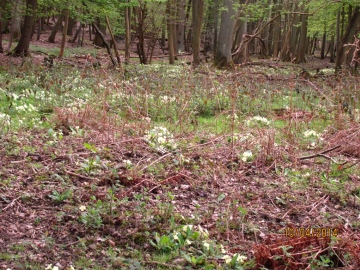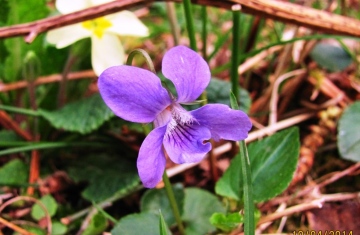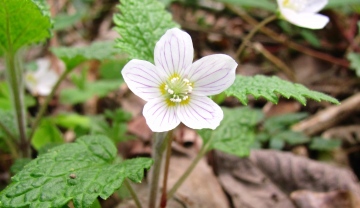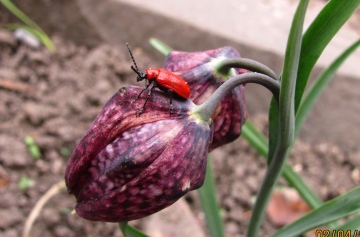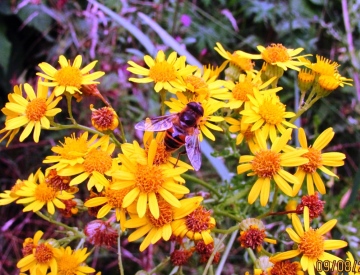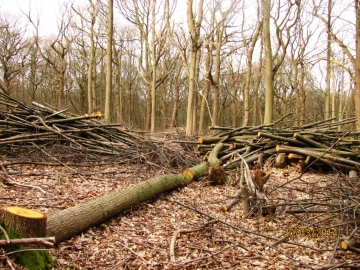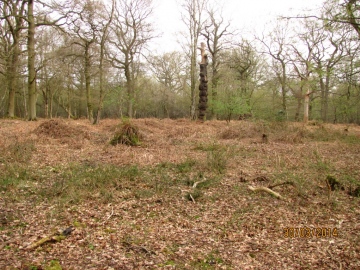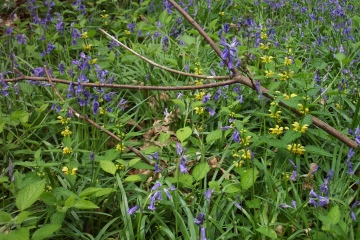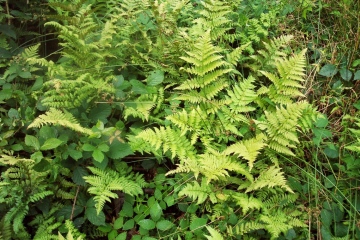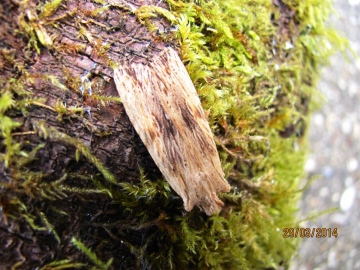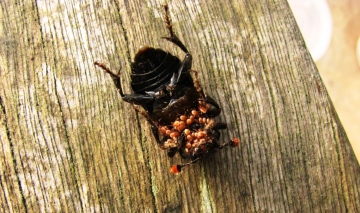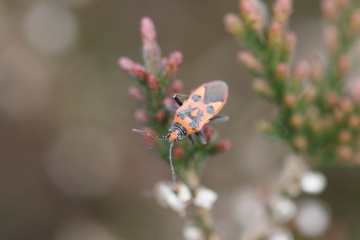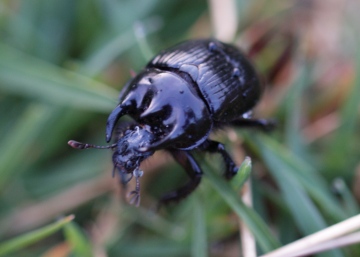Your Forum
The weblog below is for naturalists to use to report interesting sightings, ask questions, report on field meetings and generally post pictures and any information or questions generally relevant in some way to the wildlife and geology of Essex. You will need to register and be logged-on to post to the forum, and you need to upload pictures first, for use in posts. Find out more
|
Mon 21st April 2014 20:54 by Mary Smith Spring things
Thank you again, Graham.
Your piece, especially the mention of mozzies, has reminded me of the last few days, especially today.
I have seen mozzies a-plenty, but in April? Never have I seen so many biting flies (mozzies et al) so early in the year. Usually by July they become a nuisance in the evenings, and don't go until the early winter when the nights get cold with frosts. This winter we have had only one proper frost (temp below 0°C) here. Today in my garden I was planting out tomato plants, and I got bitten to pieces during the afternoon. And my garden is not boggy, either. I fear that, due to this mild, if wet, winter, that many pests and plagues have survived through it, instead of being mostly destroyed. How many millions of wasps will we see later, or, perhaps, not so much later? And gardeners will curse the millions of aphids, but perhaps ladybirds are alive in huge numbers too. We are going to see a very strange year. A number of plants are out in full flower that usually flower in late summer, but they have not stopped flowering all winter and are still doing it. Blue Fleabane was by the A13 in full flower in March. Was it early, or late, I wondered? Whichever, it was 6 months adrift. When I saw the size of the plants, it was very clear that they have been in flower all winter. Scentless Mayweed has been the same. Some annuals have grown big and branched, with rather stiff stems, and new shoots at the top, behaving like perennials. Whatever will happen next? Mon 21st April 2014 20:37 by Enid Barrie Lily beetle
This beetle is indeed a major problem for gardeners as it can totally destroy any chance of a flower. The advice given is to pick off the offending aliens and destroy them...just the same for Rosemary beetle too. It seems a great shame as they look lovely! I solved the problem by ceasing to grow lilies. Sun 20th April 2014 15:44 by Graham Smith The Mores
‘Mores’ or ‘moor’ is usually defined as a boggy area, especially one that is peaty and dominated by grasses and sedges. In the past this was probably extended to include areas of so-called ‘waste’ that were considered unfit for farming. It can also encompass a strip of open marshy ground within a wood and that is undoubtedly the meaning of ‘The Mores’, Mill Green, a narrow belt of land that separates Stoneymore Wood (Ingatestone) from Deerslade Wood (Highwood) On John Walker and Son’s parish map of 1600 it is called the ‘Common Mores’ and is depicted as a narrow extension of Mill Green Common - shaped a bit like a lady’s riding boot - which is flanked on either side by protective wood-banks. It is an open area with just a few clumps of trees and is quite distinct from the surrounding woodland. Subject to flooding in winter, it would have made for an excellent summer pasture for the Commoners’ livestock. In places, even today, relic patches of that grassland still exist, giving a flavour of what it must have looked like 400 years ago.
As a youngster it was one of my favourite destinations during Sunday morning walks with my father as Woodcock could usually be flushed from its depths in winter and in spring the ground was carpeted with Primroses, Bugle, Dog Violets and other flowers. Midsummer was a different matter though as clouds of mozzies would soon send you fleeing towards higher ground! It seemed wetter in the 1950s than it does now – the huge number of mature oaks in the adjoining woodland soaking up the rain before it reaches the valley bottom – but in the Walkers’ day it must have been a swamp in winter as the woods would have been regularly coppiced and few of the standard oaks allowed to reach the size of those present today. Despite the wettest winter on record I was able to negotiate most of it in normal walking shoes during a recent visit but much to my delight I found that despite the ravages of deer elsewhere in the wood the ground was carpeted with Primroses and Common Dog Violets. In common with other woodland valleys in the Forest the oaks are reluctant to get their roots wet and instead there is a scatter of Ash, Alder and Crack Willow, which allow a lot more light to reach the ground. Other woodland flowers such as Yellow Pimpernel, Bugle, Marsh Bedstraw, Arum, Wood Sage and these Wood Sorrel were also beginning to respond to the spring warmth; so too, alas, early rising mozzies, and several were able to advance their life cycle at my expense before I left! If the Silver-washed Fritillary is ever to return to the Forest, where it was last recorded in the 1950s, then ‘The Mores’ perhaps offers the best bet. I shall be there in the summer, looking! When I first took this photograph of a bright red beetle in the garden a couple of weeks ago I assumed that it was the Black-headed Cardinal Beetle Pyrochroa coccinea but closer inspection (while writing this!) reveals it to be the Lily Beetle Lilioceris lilii. The wing cases are more rounded, shinier and dimpled than on coccinea and the antenna are entire rather than comb-like. And the moral of this story is – don’t make assumptions! Although it has been a brilliant spring so far for butterflies and bumblebees (saw my first ‘worker’ Bombus hortorum on 7th April and first queen Cuckoo Bee B. vestalis earlier this week) other insects have been slow to appear in the garden but the Drone Fly Eristalis tenax and Tapered Drone Fly E. pertinax are now common and the Narcissus Bulb Fly Merdon equestris has recently paid me a visit. By the look of them, its grubs seem to have been munching their way through some of my Bluebell bulbs! PS : I have just read on the RHS website that the Lily Beetle is the Lily growers' nemesis! The larvae apparently defoliate lilies and fritillarias, among other plants. I fear that the one pictured emerged from the pot containing a Snakes Head Fritillary that I purchased from a local garden centre. Perhaps I should take plant and beetle back there; some gardeners that I know would do so! Sun 6th April 2014 18:03 by Graham Smith Coppicing 2
Pleasing as it is to see coppicing being resumed on a commercial scale in the Writtle Forest the quality of the work does seem to vary; in particular the amount of time and effort that is put into covering the stools after they have been cut. Work seems to have been curtailed this winter, probably due to the exceptionally heavy rainfall in the New Year, but one new site that was coppiced is in Stoneymore Wood. The contractors left after the work was carried out without covering the stools with brash and I was hoping they would return this spring to finish the job. No sign so far though. As you can see from the photo, the stump in the foreground has been left as cut. It does not matter so much with Sweet Chestnut as deer don’t seem to like the taste of it very much and the stools soon get away but the Hornbeam gets hammered and sometimes fails to recover. I was also hoping that they would thin out many of oaks as they were replanted in almost plantation like densities after the 1939-45 War and now totally dominate the wood, shading out all beneath them. They are so close together that most grow tall and straight, which you would assume adds value to their timber, but perhaps there are problems relating to felling licences when it comes to oaks. Conservationists are hard to please!
In areas where Hornbeam and Birch dominate and where the stools are not covered properly all the trees can be killed by deer. The second photo, taken in the adjoining Deerslade Wood, shows an example of this. This area was coppiced by local woodsman Martin Bacon but, sadly, he died suddenly while the work was being carried out and the stools were never covered. As you can see the clearing contains nothing but bracken and rushes apart from a single small Elder to the rear of the site. In Birch Spring the contractors have surrounded the coppiced area with 7`-8` high plastic netting to try and deter the deer. Curiously, the poles do not seem to have been hammered into the soil and so the whole structure wobbles around in the breeze and if not maintained has a tendency to collapse. This is what has happened in Ellis Wood, where the stools were not covered when the fence was erected. The result is another site where the coppice has been eaten to death. Arguably, cleared areas like this probably have some conservation value but if it happens too often it will do nothing for the profitability of the wood! Where the work is done properly a ground cover of bramble does eventually develop and provides some nesting habitat for birds for a few years before it gets shaded out but the ground flora that flourished in the increased light, even in the recent past, is now eaten by deer as soon as it pops its head above the ground! There was a herd of 100+ Fallow Deer on the edge of Stoneymore today. One of this herd had been badly injured by a car as it attempted to cross the nearby road and someone from a local equestrian centre came out to shoot it while I was there. One plant not eaten by the deer is the Bluebell and the first flowers were showing well in Writtle Park Wood today, along with some Yellow Archangel. Narrow Buckler was also well advanced for the time of year as it is not very winter green, although the photos here are cheating a bit as they were taken a few years ago! The garden moth trap is catching double the number of moths than during the similarly mild March in 2012. This may be partly due to the exceptionally mild weather throughout the winter but the fact that they now turn the street lamps off in the village at midnight may also have something to do with it. I use a 60W UV light rather than the more powerful 125W MV used by many moth trappers so the increased darkness probably adds to its efficiency, especially as my garden has ten street lamps within 75 yards of it! A pleasing capture recently was this Pale Pinion, a species new to me. In ‘The Moths of Essex’, published in 2004, it is listed as a vagrant, the only two records occurring as far back as 1903. In the past ten years though it has started to appear in ever increasing numbers and there have been several sightings reported this spring already. It is not a specialist feeder so perhaps our changing climate has encouraged its expansion, as it has done for several other species recently. A more regular capture at this time of year is the Sexton or Burying Beetle Nicrophorus humator. This one is carrying some spare baggage in the form of gamasid mites which apparently use their host as a taxi service to new areas without doing it much harm! Tue 1st April 2014 21:41 by Robert Smith Minotaur beetle 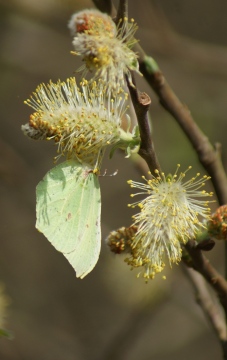 A trip to Mill Green Common this lunchtime caught the lovely sight of a female Brimstone nectaring on Sallow. There were a few other males along the lanes of Fryerning but this one was probably fueling up before egglaying on the many Alder Buckthorn to be found on the common. A trip to Mill Green Common this lunchtime caught the lovely sight of a female Brimstone nectaring on Sallow. There were a few other males along the lanes of Fryerning but this one was probably fueling up before egglaying on the many Alder Buckthorn to be found on the common.
There was encouraging new growth on old and new heather shoots and on one, a striking bug - Corizus hyoscyami.
A return trip after work revealed a Minotaur beetle, an uncommon dung beetle that was first found on the common only last year - nice to get a follow-up. |
Archives: May 2020Aug 2019 Jan 2019 Sep 2018 Jul 2016 Oct 2015 Jul 2015 May 2015 Apr 2015 Mar 2015 Feb 2015 Jan 2015 Dec 2014 Oct 2014 Sep 2014 Aug 2014 Jul 2014 May 2014 Apr 2014 Mar 2014 Feb 2014 Jan 2014 Dec 2013 Nov 2013 Sep 2013 Aug 2013 Jul 2013 Jun 2013 May 2013 Apr 2013 Mar 2013 Feb 2013 Jan 2013 Dec 2012 Nov 2012 Oct 2012 Sep 2012 Aug 2012 Jul 2012 Jun 2012 May 2012 Apr 2012 Mar 2012 Feb 2012 Jan 2012 Dec 2011 Nov 2011 Oct 2011 Sep 2011 Aug 2011 Jul 2011 Jun 2011 May 2011 Apr 2011 Mar 2011 Feb 2011 Jan 2011 Dec 2010 Nov 2010 Oct 2010 Sep 2010 Aug 2010 Jul 2010 Jun 2010 May 2010 Apr 2010 Mar 2010 Feb 2010 Nov 2009 Oct 2009 Aug 2009 Jul 2009 Jun 2009 May 2009 Apr 2009 Mar 2009 Feb 2009 Jan 2009 Nov 2008 Oct 2008 Sep 2008 Aug 2008 Jul 2008 Jun 2008 May 2008 Apr 2008 Mar 2008 Feb 2008 Jan 2008 Dec 2007 Nov 2007 current posts |



















